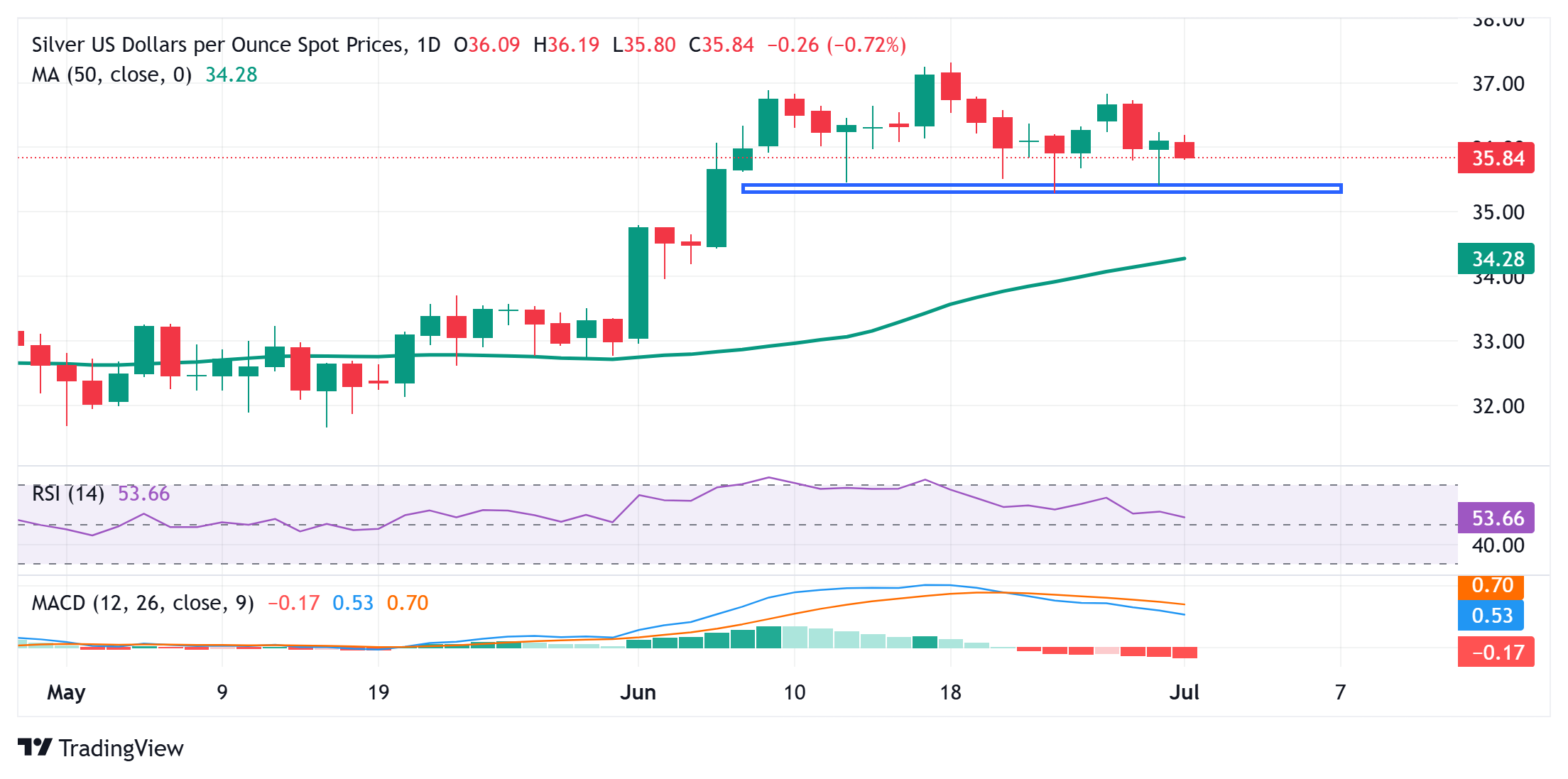Silver Price Forecast: XAG/USD struggles below $36.00 mark; bears seem non-committed
- Silver meets with a fresh supply and stalls the overnight recovery from a multi-day low.
- The mixed technical setup warrants some caution before positioning for deeper losses.
- A sustained strength beyond $37.00 is needed to negate any near-term negative bias.
Silver (XAG/USD) struggles to capitalize on the overnight goodish rebound from the $35.40 area or a multi-day trough and attracts fresh sellers during the Asian session on Tuesday. The white metal currently trades around the $35.85 region, down 0.70% for the day.
From a technical perspective, the Moving Average Convergence Divergence (MACD) histogram and the signal line on the daily chart have turned lower. However, the daily Relative Strength Index (RSI, 14) remains above 50, warranting some caution for the XAG/USD bears and before positioning for deeper losses. Hence, any subsequent fall might continue to find decent support near the $35.50-$35.40 horizontal zone.
Against the backdrop of last week's failure near the $37.00 mark, a convincing break below the said support could prompt some technical selling and make the XAG/USD vulnerable to accelerate the fall toward the $35.00 psychological mark. Some follow-through selling could drag the commodity further toward intermediate support near the $34.75 area en route to the next relevant support near the $34.45 region.
On the flip side, any move beyond the $36.00 round figure might now confront some hurdle near the $36.20 region. A sustained strength beyond the latter could allow the XAG/USD to make a fresh attempt towards conquering the $37.00 mark and retest the highest level since February 2012, around the $37.30-$37.35 region touched earlier this month. The subsequent move up should pave the way for an extension of a nearly three-month-old uptrend.
Silver daily chart

Silver FAQs
Silver is a precious metal highly traded among investors. It has been historically used as a store of value and a medium of exchange. Although less popular than Gold, traders may turn to Silver to diversify their investment portfolio, for its intrinsic value or as a potential hedge during high-inflation periods. Investors can buy physical Silver, in coins or in bars, or trade it through vehicles such as Exchange Traded Funds, which track its price on international markets.
Silver prices can move due to a wide range of factors. Geopolitical instability or fears of a deep recession can make Silver price escalate due to its safe-haven status, although to a lesser extent than Gold's. As a yieldless asset, Silver tends to rise with lower interest rates. Its moves also depend on how the US Dollar (USD) behaves as the asset is priced in dollars (XAG/USD). A strong Dollar tends to keep the price of Silver at bay, whereas a weaker Dollar is likely to propel prices up. Other factors such as investment demand, mining supply – Silver is much more abundant than Gold – and recycling rates can also affect prices.
Silver is widely used in industry, particularly in sectors such as electronics or solar energy, as it has one of the highest electric conductivity of all metals – more than Copper and Gold. A surge in demand can increase prices, while a decline tends to lower them. Dynamics in the US, Chinese and Indian economies can also contribute to price swings: for the US and particularly China, their big industrial sectors use Silver in various processes; in India, consumers’ demand for the precious metal for jewellery also plays a key role in setting prices.
Silver prices tend to follow Gold's moves. When Gold prices rise, Silver typically follows suit, as their status as safe-haven assets is similar. The Gold/Silver ratio, which shows the number of ounces of Silver needed to equal the value of one ounce of Gold, may help to determine the relative valuation between both metals. Some investors may consider a high ratio as an indicator that Silver is undervalued, or Gold is overvalued. On the contrary, a low ratio might suggest that Gold is undervalued relative to Silver.
